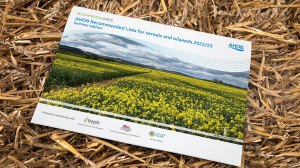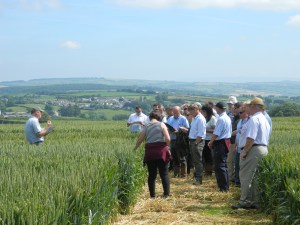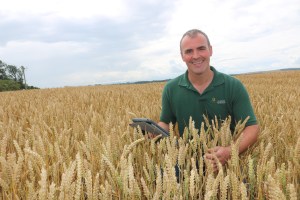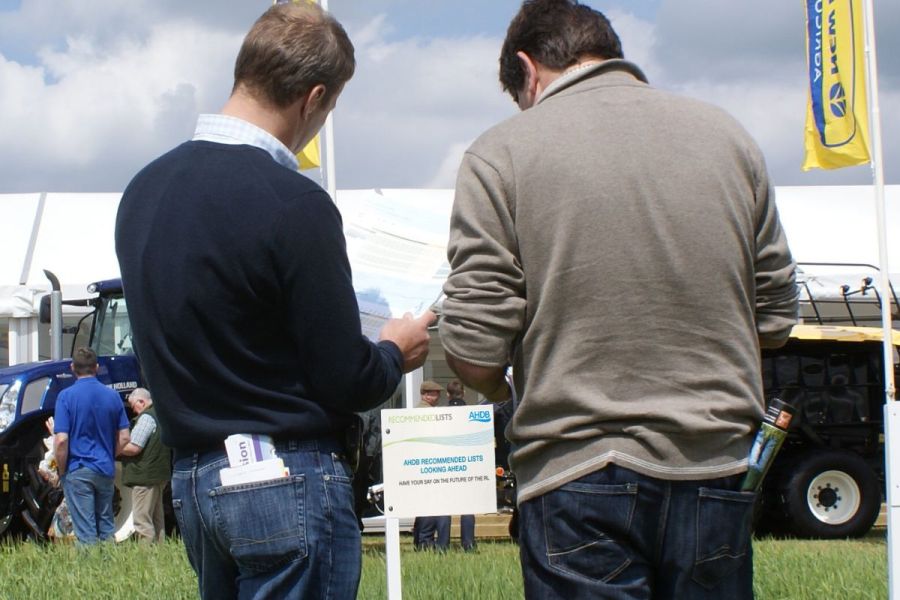The Recommended List system has changed over the years and always scores high for grower satisfaction. Just ahead of a detailed review, CPM finds out how levy payers can have their say and what potential changes are on the horizon.
“The best way to steer the ship is to get on board and engage.”
By Adam Clarke
It was almost 80 years ago that NIAB produced the first wheat Descriptive List, providing growers with information on 16 varieties.
Since then, what is now the AHDB Recommended List for Cereals and Oilseeds has evolved into a multi-million-pound project that recommends or describes varieties of 11 different crop types.

The Recommended Lists achieved the highest score for levy payer satisfaction of any AHDB Cereals & Oilseeds offering in a recent consultation.
The project is managed by a consortium which consists of AHDB, British Society of Plant Breeders (BSPB), Maltsters’ Association of Great Britain (MAGB) and UK Flour Millers (UKFM).
Despite its Titanic size, the RL management team could be said to have done a fine job of avoiding any icebergs in recent years – it achieved the highest score for levy payer satisfaction of any AHDB Cereals & Oilseeds offering in the recent Shape the Future industry consultation.
However, with arable producers in a period of rapid change, the project can’t rest on its laurels and must continue to evolve to reflect what is happening on the ground, according to AHDB’s head of crop health and IPM, Jenna Watts.

The project can’t rest on its laurels and must continue to evolve to reflect what is happening on the ground, says Jenna Watts.
AHDB will soon launch a large-scale public review of the current RL project phase – each phase typically runs for five years – and Jenna encourages everyone to have their say on potential improvements.
She adds that consistently high importance and satisfaction scores underline how critical Recommended Lists are to crop management and has inspired the latest review to be the biggest and most detailed ever conducted.
“There are so many challenges facing growers at the moment and the RL must help meet some of these,” says Jenna.
This review will cover every operational aspect of the RL project, including costs, trials, data types and analysis, selection, and removal criteria, plus its presentation and communication.
The RL project has a total value of more than £22M, based on contributions from all consortium members in its current five-year phase. Levy payers are the largest contributors, with AHDB adding £8M of cash plus more on staff time, knowledge exchange and communications work.
Understandably, there has been particular emphasis on costs and efficiency to ensure that the project delivers value for money for its primary funders – the levy payer.
While economics will still be an integral part of the upcoming review, there will be an increased emphasis on what could be fine-tuned or added to provide the most relevant information as the arable sector continues to evolve.
“Before, the reviews have very much looked at what we’ve got, but this time we want to look at specific growers’ needs when choosing varieties, and how the RL can deliver on those needs,” says Jenna.
That’s not to say there haven’t been any needs-based changes over recent years.
Review activities since the 2010s have highlighted the increased importance of disease resistance relative to treated yields.
In the last major RL review, between 2017 and 2019, most respondents rated disease resistance and untreated yield as very important or crucial when selecting a variety. This reflected increasing concern about controlling foliar disease with a dwindling and less effective fungicide armoury.
This resulted in visible changes to the RL since the early 2010s, with a line for untreated yields given more prominence, and some changes in the background, most notably the criteria for a variety to be automatically recommended.
Rather than just headline yield, varieties must pass minimum standards for disease resistance, with a score of 3 the bare minimum for most diseases. However, for the most important diseases in key crops, the minimum standard is higher and there are additional criteria for automatic recommendation.
For example, for automatic selection oilseed rape candidates in the East/West region need a 6 for both phoma stem canker and light leaf spot, while winter wheats must have at least a 5 for Septoria tritici in addition to a high treated yield/gross output.
Where a variety doesn’t meet these specific thresholds, the relevant crop committee would take a forensic look at its overall package and make a balanced judgement on whether it is worthy of recommendation for a specific, useful characteristic such as quality.

Feedback from industry on ideas such as a Premiership table will be gleaned from grower focus groups planned as part of the upcoming RL review.
The sheer number of varieties that are on the lists has been a nagging criticism over recent years, although recent feedback suggests that it is not an important issue for all users.
However, some believe it’s confusing and to help address this, AHDB recently developed the Variety Selection digital tools, which allow users to filter varieties and focus on those suited to their own situation.
This is achieved by giving certain traits greater agronomic merit, depending on where the grower is in the country. For example, brown rust might be of higher importance in the East than in the North.
“Agronomic merit brings together all disease resistance and lodging data and gives you a single figure, rather than having to delve into the whole list itself.
“Having lots of varieties brings choice, but there needs to be a way of narrowing down that choice to make the process much simpler,” says Jenna.

AHDB recently developed the Variety Selection digital tools, which allow users to filter varieties and focus on those suited to their own situation.
However, Jenna accepts that things may need to go further in the future, perhaps by presenting the data in a different way or developing the digital offering.
One idea is to have a tiered system, where the top yielding and agronomically robust varieties are in a Premiership table, with others suitable for specific markets or regions presented in other divisions.
This is a topic where Jenna would really value feedback from industry, and there will be the opportunity to do so in grower focus groups planned as part of the upcoming RL review.
There will also be an online questionnaire launched alongside the 2023-24 RL, plus ways to engage at events over winter.
Information on how to get involved in the focus groups and any other aspect of the review are on the AHDB Cereals and Oilseeds website.
Gathered information will be analysed during the spring and after stakeholder meetings, which include the plant breeders, an action plan for the next phase of RL funding will be published in the autumn.
Jenna is reluctant to speculate on the outcome of the review, but areas such as variety performance when direct drilled and response to different fungicide regimes are potential topics that will be subject to detailed discussion.
“The Recommended List can’t be everything to everyone, so we need to have this discussion and take a balanced view of how we move forward,” she adds.
RL updates may require higher levy

Patrick Stephenson says levy payers may have to pay more to see the potential benefits.
Yorkshire-based AICC agronomist and RL review steering group chairman Patrick Stephenson agrees the list is not immune to change and must reflect the changing needs of industry.
However, there is a cost to making changes and a levy increase might be required to deliver some of the data that some growers and agronomists demand.
He says the RL has been fit for purpose during a stable period for arable producers, who have been supplied with an effective and diverse armoury of plant protection products.
But the landscape is rapidly changing, with pesticide pipelines slowing to a dribble and pressure increasing on growers to use fewer synthetic inputs.
This means it will be important to adjust RL trials protocols that currently show a variety’s genetic potential when treated with a fungicide programme costing about £240/ha.
“Historically, variety choice was a smaller part of the puzzle, but as we move to a more integrated approach, traits are a greater part of the equation. We must accept that pragmatism is required when it comes to trial protocols,” says Patrick.
Another hot topic is establishment method, with a move to less or no tillage gathering momentum. Current RL protocols do not reflect this reality, he says.
But incorporating direct drilling into RL trials – as they are currently laid out – is not as straightforward as it might appear, he notes. Small plot drills are light and don’t have the ability to produce enough coulter pressure to work effectively.
However, testing varieties under no-till conditions to generate independent data will help cater for the increasing proportion of direct-drilling levy payers.
“Not everything can be done using no-till or regenerative standards, as practitioners remain in the minority. However, the system does need to produce a greater spread of information for levy payers working to those standards,” he adds.
There is plenty of noise around variety blends, too, which offers another conundrum for the RL management team.
Evidence suggests that blends with a variety of strengths and weaknesses can help produce more stable yields across different seasons, but the difficulty of incorporating blends into a centralised testing system is that grower and market needs will vary greatly.
Various millers may have different requirements from a Group 1 blend, while a feed wheat blend in Cornwall will require different constituent parts to one grown in the Cambridgeshire fens.
“One potential solution is to trial a yellow rust blend near Kings Lynn, a septoria blend in Cornwall or South Wales. These would provide a benchmark on what blends can achieve in relation to other options in specific situations,” explains Patrick.
One change Patrick would personally like to see is how the system deals with data anomalies in some trials.
These outliers – such as when a variety unexpectantly fails – are taken out of the system, but that data may have some regional significance that some growers might find useful.
Also, up to the point of trial failure, there might be some data gathered, like vigour scores, that would also provide valuable insight.
“At the moment, all that information is lost, and I think it’s wasteful. What we’d like is a place at the back of the machine where growers can access that information where relevant,” he says.
The elephant in the room when discussing these potential additions to the RL dataset is cost of additional trials and Patrick says inevitably, levy payers may have to pay more to see the potential benefits.

David Bell sees the RL as the cornerstone of integrated pest management.
One of those levy payers is David Bell, who runs a mixed farming enterprise near St Andrews, Fife, and now sits on the RL review steering committee alongside Patrick.
He sees the RL as the cornerstone of integrated pest management (IPM) and one of the best sources of independent data to help growers with decision making and question commercial advice.
David sees a need to have an “adult conversation” about the levy, which has remained the same for 12 years and effectively resulted in a real-terms budget cut for AHDB Cereals and Oilseeds, restricting its ability to expand the RL’s remit as some demand.
He also stresses the importance of engaging with the upcoming review to help identify area to improve and establish how much additional funding might be required.
“The best way to steer the ship is to get on board and engage, whether in meetings or via the questionnaire.
“If we do want change, then give AHDB some direction. The RL belongs to the levy payers, and we must communicate what we want and offer some constructive ideas on how we can make it better,” he adds.
Research Roundup
From Theory to Field is part of AHDB’s delivery of knowledge exchange on grower-funded research projects. CPM would like to thank AHDB for its support and in providing privileged access to staff and others involved in helping put these articles together.
For further info:
AHDB Project P2110377: AHDB Recommended Lists for cereals and oilseeds (2021-26) is led by a consortium, including AHDB, British Society of Plant Breeders (BSPB), Maltsters’ Association of Great Britain (MAGB) and UK Flour Millers (UKFM).
For more detail about the project, click here.
This article was taken from the latest issue of CPM. For more articles like this, subscribe here.




